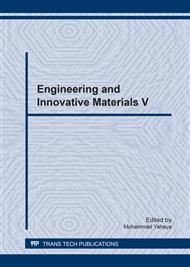[1]
R. Echigo, Effective Energy Conversion Method between Gas Enthalpy and Thermal Radiation and Application to Industrial Furnaces. Proc. 7th Int. Heat Transfer Conf. Vol. 6 (1982), pp.361-366.
DOI: 10.1615/ihtc7.2500
Google Scholar
[2]
K. Y. Wang and C. L. Tien, Thermal insulation in flow system: Combined radiation and convection through a porous segment. ASME. J. Heat Transfer Vol. 106 (1984), pp.453-459.
DOI: 10.1115/1.3246693
Google Scholar
[3]
P. Khantikomol and K. Kamiuto, Design Considerations of Porous Gas Enthalpy-Radiation Converters for Exhaust-Heat Recovery Systems. J. Thermal Science and Technology Vol. 3 No. 2 (2008), pp.319-329.
DOI: 10.1299/jtst.3.319
Google Scholar
[4]
P. Khantikomol, S. Saito and K. Kamiuto, Combined convection and radiation heat transfer in an open-cellular plate. 7th JSME-KSME Thermal and Fluids Engineering Conf, Sapporo Japan (2008).
Google Scholar
[5]
P. Khantikomol, S. Saito and T. Yokomine, Study of Multilayer Flow Insulation utilizing Open-Cellular Porous Plates. Proc. Int. Conf. Power Engineering (ICOPE-09) Vol. 3 (2009), pp.37-42.
DOI: 10.1299/jsmeicope.2009.3._3-37_
Google Scholar
[6]
P. Khantikomol and K. Kamiuto, Combined Forced-Convection and Radiation Heat Transfer in an Open-Cellular Porous Plate. Proc. of Int. Conf. on Thermal and Fluids Engineering (The 7th JSME-KSME) (2008).
Google Scholar
[7]
K. Kamiuto, Study of Dul'nev's Model for the Thermal and Radiative Properties of Open-Cellular Porous Materials. JSME Int. J., Series B Vol. 40 (1997), pp.577-582.
DOI: 10.1299/jsmeb.40.577
Google Scholar
[8]
K. Kamiuto, Combined conductive and radiative heat transfer through open-cellular porous plates. JSME Int. J., Series B Vol. 43 (2000), pp.273-278.
DOI: 10.1299/jsmeb.43.273
Google Scholar
[9]
K. Kamiuto, Modeling of elementary transport processes and composite heat transfer in open-cellular porous materials. Trends in Heat, Mass & Momentum Transfer Vol. 5 (1999), pp.141-161.
DOI: 10.1002/9783527621408.ch6
Google Scholar
[10]
K. Kamiuto, S. Saito and K. Ito, Numerical model for combined conductive and radiative heat transfer in annular packed beds. Numerical Heat Transfer Part A Vol. 23 (1993), pp.433-443.
DOI: 10.1080/10407789308913681
Google Scholar
[11]
K. Kamiuto and San San Yee, Heat Transfer Correlations for Open-Cellular Porous Materials, Int. Communi. Heat Mass Transfer, Vol. 32 No. 7 (2005), pp.947-953.
DOI: 10.1016/j.icheatmasstransfer.2004.10.027
Google Scholar
[12]
K. Kamiuto and T. Matsushita, High-temperature radiative properties of open-cellular porous materials, Proc. 11th Int. Heat Transfer Conf., Vol. 7 (1998), pp.385-390.
Google Scholar
[13]
P. Grootenhuis, The mechanism and applicationof effusion cooling. Journal of the Royal Aeronautic Society Vol. 63 (1959), p.73–89.
Google Scholar
[14]
Bayley FJ (1970) Transpiration cooled turbines. Proc. Inst. Mech. Engineering 185: 943-956.
Google Scholar
[15]
S. H. Choi, S. J. Scotti, K. D. Song and H. Ries, Transpiring cooling of a scram-jet engine combustion chamber, NASA AIAAA-97-2576 (1997).
DOI: 10.2514/6.1997-2576
Google Scholar
[16]
Glass DE, Dilley AD and Kelly HN (2001) Numerical analysis of convection/ transpiration cooling. AIAA J Spacecraft Rockets Vol. 38 No. 1 (2001), p.15–20.
DOI: 10.2514/2.3666
Google Scholar
[17]
P. Amatachaya, B. Krittacom, P. Khantikomol and R. Songchot, Transpiration Cooling System Using Cordierite - Alumina Open – Cellular Porous Material,. The 8th Thermal and Fluid Engineering Conf. (2011), pp.1-4.
Google Scholar


